So, I'm not sure if this is the right location to post this. But, when I first started posting on the forum, I mentioned that I was a falconer and some people expressed interest in seeing some photos and a knowing a bit about it. So, here it goes!
I'll start off with a bit of an explanation, then the photos. Falconry is probably the most highly regulated hunting sport in the US. Other parts of the world aren't as stringent. Here in the US, to become a falconer, you must find a General or Master class falconer that is willing to sponsor you for 2 years and supervise and teach you. You start as an Apprentice for 2 years, then progress to General class for 5 more years. At each stage, you are allowed to possess more and different species of birds. The most common starting bird is a Red Tailed Hawk, and that is what my first bird was. I've been a falconer for 9 years, which makes me a Master class.
Generally the first bird or birds a falconer hunts with are trapped from the wild when they are under a year old. This is because birds of prey have a nearly 80% mortality rate their first year, so the small take by falconers doesn't affect wild populations. These birds can also be released to the wild at a later date. After a bird is trapped, the falconer spends a lot of time calmly sitting with the bird getting it to trust you. Eventually, the bird will eat off of the glove. Then, you get the bird stepping to the glove, and finally hopping or flying progressively longer distances. While training, you also introduce a lure to the bird, which is usually a leather bag that has a larger piece of meat attached than you would give them on the glove. They get to really like their lure and will usually come long distances for it knowing it has a large meal. Once the bird is responding instantly to you and the lure at long distances (sometimes up to 100 yards) you are ready to start hunting.
The most common game for a Red Tail is either rabbits, jackrabbits, or squirrels. When flying a falcon, the typical game is ducks, pheasants, quail and other game birds. Falconers usually have extended seasons compared to gun hunting because the success rate of falconers is usually much lower than gun hunters.
If anybody has any questions, I'd be happy to answer them!
This is Adelaide (my Red Tail) on the day I trapped her.
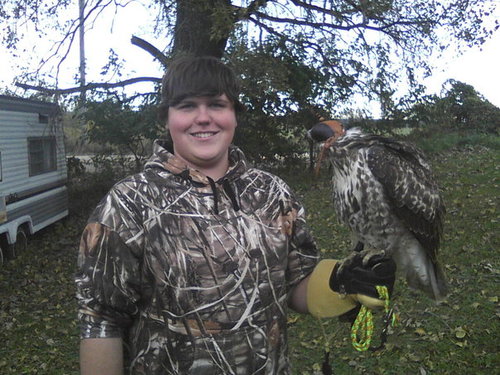
Our first rabbit together. 30 days of training after I trapped her.
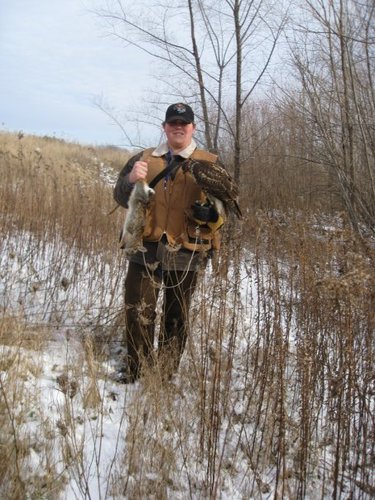
First double on rabbits. That is my sponsor in the photo with me.
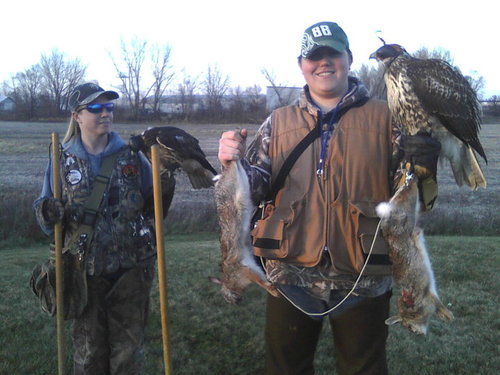
Our first Jackrabbit after moving out West.
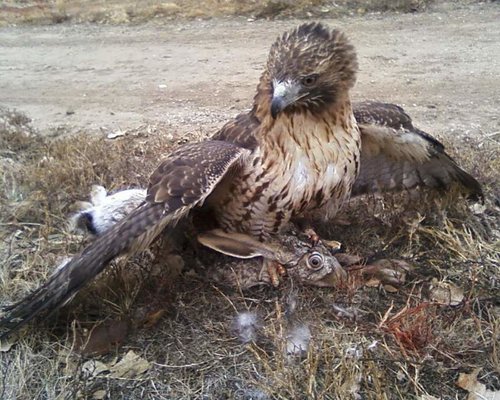
Adelaide as an Adult.
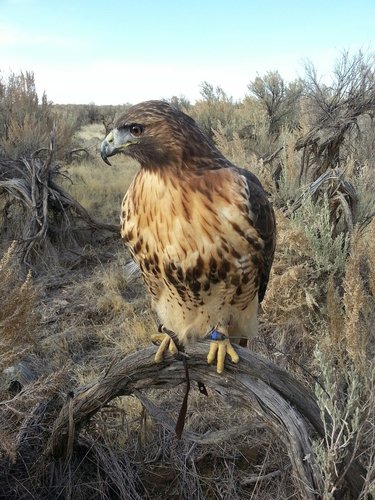
Not sure why the other photos showed up in the end there, but here's some captions...
One is my friend's Red Tail using my head as a landing spot.
Then, a Golden Eagle I got to hunt with.
Then Adelaide snagging a Jackrabbit.
A friends Gyrfalcon.
A friend's Prairie Falcon on a pheasant.
And my friend's Peregrine Falcon.
I'll start off with a bit of an explanation, then the photos. Falconry is probably the most highly regulated hunting sport in the US. Other parts of the world aren't as stringent. Here in the US, to become a falconer, you must find a General or Master class falconer that is willing to sponsor you for 2 years and supervise and teach you. You start as an Apprentice for 2 years, then progress to General class for 5 more years. At each stage, you are allowed to possess more and different species of birds. The most common starting bird is a Red Tailed Hawk, and that is what my first bird was. I've been a falconer for 9 years, which makes me a Master class.
Generally the first bird or birds a falconer hunts with are trapped from the wild when they are under a year old. This is because birds of prey have a nearly 80% mortality rate their first year, so the small take by falconers doesn't affect wild populations. These birds can also be released to the wild at a later date. After a bird is trapped, the falconer spends a lot of time calmly sitting with the bird getting it to trust you. Eventually, the bird will eat off of the glove. Then, you get the bird stepping to the glove, and finally hopping or flying progressively longer distances. While training, you also introduce a lure to the bird, which is usually a leather bag that has a larger piece of meat attached than you would give them on the glove. They get to really like their lure and will usually come long distances for it knowing it has a large meal. Once the bird is responding instantly to you and the lure at long distances (sometimes up to 100 yards) you are ready to start hunting.
The most common game for a Red Tail is either rabbits, jackrabbits, or squirrels. When flying a falcon, the typical game is ducks, pheasants, quail and other game birds. Falconers usually have extended seasons compared to gun hunting because the success rate of falconers is usually much lower than gun hunters.
If anybody has any questions, I'd be happy to answer them!
This is Adelaide (my Red Tail) on the day I trapped her.

Our first rabbit together. 30 days of training after I trapped her.

First double on rabbits. That is my sponsor in the photo with me.

Our first Jackrabbit after moving out West.

Adelaide as an Adult.

Not sure why the other photos showed up in the end there, but here's some captions...
One is my friend's Red Tail using my head as a landing spot.
Then, a Golden Eagle I got to hunt with.
Then Adelaide snagging a Jackrabbit.
A friends Gyrfalcon.
A friend's Prairie Falcon on a pheasant.
And my friend's Peregrine Falcon.
Attachments
Last edited:










